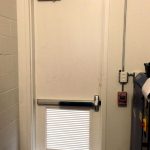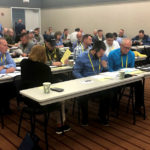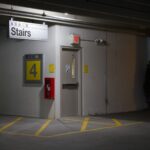 When the model codes require panic hardware for doors serving an assembly or educational/day-care occupancy, the panic hardware is required for all doors serving those spaces if the doors are equipped with a lock or latch. This would apply to any door in the path of egress between the space that requires panic hardware and the public way. But what about electrical room doors that require panic hardware? Today’s Quick Question:
When the model codes require panic hardware for doors serving an assembly or educational/day-care occupancy, the panic hardware is required for all doors serving those spaces if the doors are equipped with a lock or latch. This would apply to any door in the path of egress between the space that requires panic hardware and the public way. But what about electrical room doors that require panic hardware? Today’s Quick Question:
If an electrical room is required to have outswinging doors with panic hardware, does this requirement apply to all of the doors that are part of the means of egress between the electrical room and the public way?
The short answer: no. For the long answer, read on.
Some rooms that contain electrical equipment are required by code to have outswinging doors that are equipped with listed panic hardware or fire exit hardware. These requirements are found in model codes like NFPA 70 – National Electrical Code and the International Building Code (IBC). It’s important to check the adopted codes for specifics, but this Decoded article can give you some guidance.
The 2002 edition of NFPA 70 was the first edition to include requirements for panic hardware on some electrical rooms, but there have been many modifications since then, clarifying the intent and in some cases expanding the mandates to cover additional rooms. Beginning with the 2008 edition, the NEC has included language stating that doors within 25 feet of the required working space around the equipment in these rooms must have panic hardware (or fire exit hardware if a fire door assembly is required).
Here is an example of the language from NFPA 70:
Where there are personnel doors intended for entrance to and egress from the working space less than 7.6 m (25 ft) from the nearest edge of the working space, the doors shall open in the direction of egress and be equipped with listed panic hardware or listed fire exit hardware.
This means that if a door is part of the means of egress from the room and is within 25 feet of the working space that is required by code around the electrical equipment, the code requires the door to have panic hardware. The NEC does not specifically state that the requirement for panic hardware applies only if the door is equipped with a lock or latch (and would not apply to a door with a push plate and pull), but the IBC does clarify this by stating: such doors shall not be provided with a latch or lock other than panic hardware or fire exit hardware.
Because of the 25-foot stipulation, panic hardware is not required for doors that are part of the means of egress between the electrical room and the public way; the intent is to allow a technician to exit the room easily if there is a fire or explosion. According to enhanced content provided by NFPA: Door-opening hardware must not require the turning of a door knob or similar action that could preclude quick exit from the area in the event of an emergency. This requirement allows an injured worker to exit from the equipment room without having to turn knobs or pull doors open.
Remember, not every electrical room requires doors with panic hardware – it depends on the voltage, amperage, and other electrical equipment specifications. Check the adopted code in your project’s jurisdiction for prescriptive requirements.
You need to login or register to bookmark/favorite this content.










I recall a conversation I had with an electrician or an electrical engineer years ago about this. Electrical current will pass through the body (hand in contact with a conductor to the opposite hand.) if this is on a doorknob or lever the electricity conducted through muscle tissue can cause the muscles to contract and we lose the ability to move some or all of our body. The door swings out so as to allow a person who might fall into it to fall out of the room and away from the hazard, but if they fall in front of a door that swings in the door may obstruct efforts to aid or rescue them.